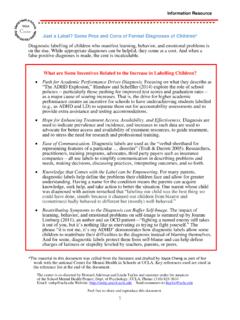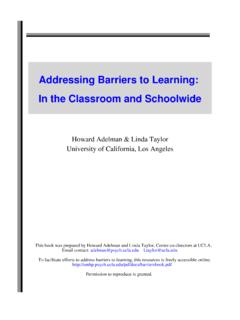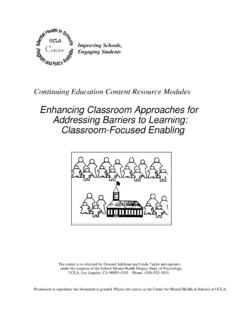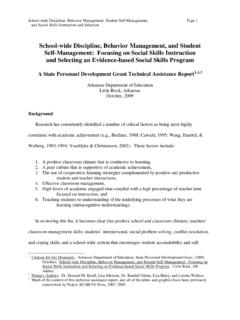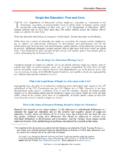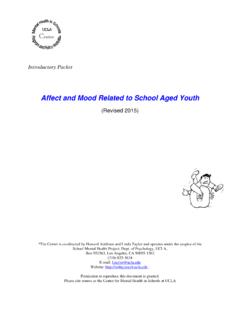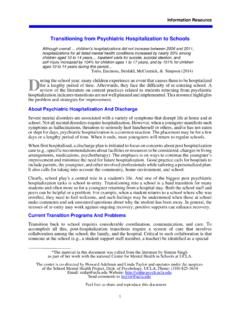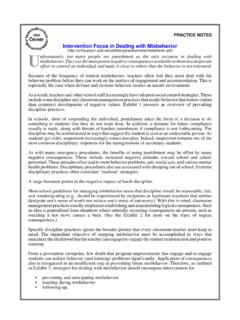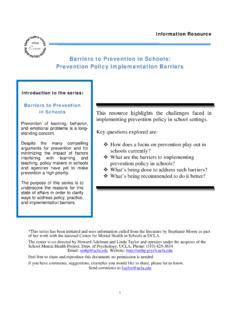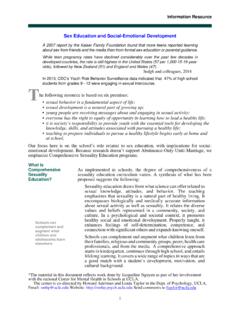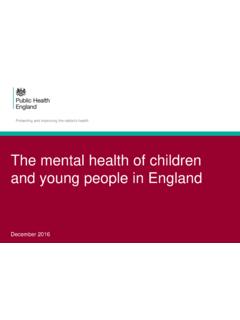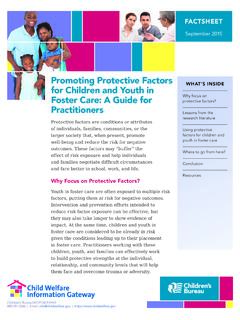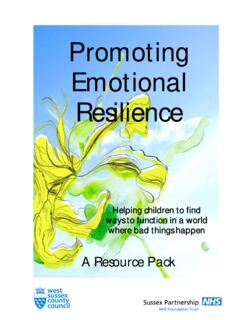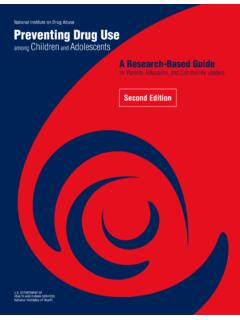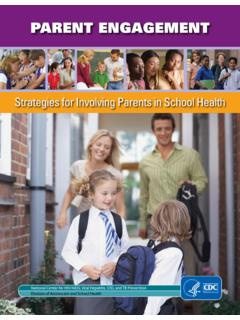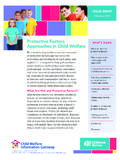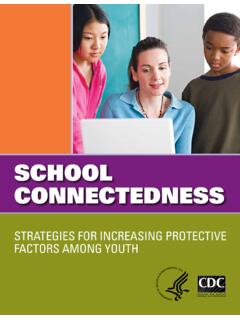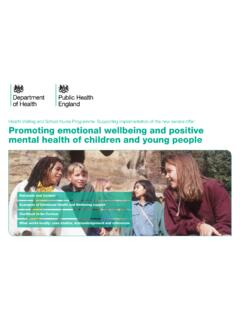Transcription of Protective Factors Resiliency - University of California ...
1 Technical Assistance Sampler Protective Factors / Resiliency (Updated 2016)*The Center is co-directed by Howard Adelman and Linda Taylor and operates under the auspice of theSchool Mental Health Project, Dept. of Psychology, UCLA,Box 951563, Los Angeles, CA 90095-1563(310) 825-3634E-mail: Website: .Permission to reproduce this document is cite source as the Center for Mental Health in Schools at UCLAP rotective Factors /ResiliencyIntroduction>Barriers (Risk Factors ), Protective Buffers, and promoting Full >Resilience as a Dynamic Concept (abstract)..4>Reflections on 5I. What is Resiliency ?..6 A. Resilience as a Dynamic Conceptusions)..7 B. 10 Tips for Building Resilience in Children and C.
2 Protective Research ,,.. & ..50A. B. Agencies, Organizations, & Internet Quick D. Childhood E. Risk and Protective F. Protective and Promotive About The Efficacy of Resiliency Training A Public Health School-Based ..26B. Community and Assessing Personal Methodlogical Policy and (Risk Factors ), Protective Buffers, and Promotion of Full DevelopmentAs terms such as resilience and Protective Factors are popularized, confusion andsome controversies have arisen. In particular, an ongoing discussion centers on howto reconcile differences among advocates of addressing risks and those who stressasset building and youth development. Perhaps the following distinctions will Factors .
3 One way to think about risk Factors is in terms of potentialexternal and internal barriers to development and learning. Research indicatesthat the primary causes for most youngsters learning, behavior, and emotionalproblems are external Factors (related to neighborhood, family, school, and/orpeers). For a few, problems stem from individual disorders and facet of any emphasis on addressing barriers is guided by the research onrisk Factors . Protective Factors are conditions that buffer against theimpact of barriers (risk Factors ). Such conditions may prevent or counter riskproducing conditions by promoting development of neighborhood, family,school, peer, and individual strengths, assets, corrective interventions, copingmechanisms, and special assistance and accommodations.
4 The term resilienceusually refers to an individual s ability to cope in ways that buffer. Researchon Protective buffers also guides efforts to address barriers. promoting full development. As often is stressed, being problem-free is notthe same as being well-developed. Efforts to reduce risks and enhanceprotection can help minimize problems but are insufficient for promoting fulldevelopment, well-being, and a value-based life. Those concerned withestablishing systems for promoting healthy development recognize the needfor direct efforts to promote development and empowerment, including themobilization of individuals for self-pursuit. In many cases, interventions tocreate buffers and promote full develop-ment are identical, and the pay-off isthe cultivation of developmental strengths and assets.
5 However, promotinghealthy development is not limited to countering risks and engenderingprotective Factors . Efforts to promote full development represent ends whichare valued in and of themselves and to which most of us aspire2 Considerable bodies of research and theory have identified major correlates that are usefulguideposts in designing relevant interventions. And, as the examples in the box on the nextpage illustrate, there is a significant overlap in conceptualizing the various Factors . Somebarriers to development and learning (risk Factors ) and Protective buffers are mirror images;others are distinct. Many Protective buffers are outcomes of efforts to engender fulldevelopment.
6 From the perspective of interventions designed to address barriers to learningand development, promoting healthy development is the other side of the coin, and whenthese are done well, resilient behavior, individual assets, and healthy behavior in childrenand adolescents are engendered. Thus, Protective buffers are a natural by-product of comprehensive, multifaceted efforts toreduce risk Factors and foster positive development, but the aims of such efforts go wellbeyond what research has established so far as Protective Factors It is a mistake, of course,to jump too quickly from research that identifies compelling correlates to makingassumptions about cause and effect.
7 This is especially so when one understands that behavioris reciprocally determined ( , is a function of person and environment transactions). Manyconcepts labeled as risk and Protective Factors are so general and abstract ( , communitydisorganization, quality of school) that they will require many more years of research toidentify specific causal variables. At the same time, it is evident that these general areas areof wide contemporary concern and must be addressed in ways that represent the bestevidence and wisdom that can be derived from the current knowledge base. The same is trueof efforts to promote mistake is to take lists of risk Factors , symptoms, or assets and directly translatethem into specific intervention objectives.
8 The temptation to do so is great especially sincesuch objectives often can be readily measured. Unfortunately, this type of approach is oneof the reasons there is so much inappropriate and costly program and service is also a reason why so many empirically supported interventions seem to account for onlya small amount of the variance in the multifaceted problems schools must address inenabling student learning. And, with respect to promoting development, such a piecemealapproach is unlikely to produce holistic school where large numbers of students manifest learning, behavior, and emotionalproblems needs to implement a comprehensive, multifaceted, and cohesive continuum ofinterventions.
9 This continuum must address barriers (reducing risks, enhancing buffers) andpromote full development. Policy makers and researchers must move beyond the narrow setof empirically supported programs to a research and development agenda that pieces togethersystematic, comprehensive, multifaceted approaches so that schools are effective in re-engaging the many students who have become disengaged from classroom learning and whoare leaving school in of Barriers to Learning, Development,, Protective Buffers, and Promotion of Full Development* E N V I R O N M E N T A L C O N D I T I O N S**PERSON Factors **I. Barriers to Development and Learning (Risk producing conditions) Neighborhood Family School and Peers Individual>extreme economic deprivation>community disorganization, including high levels of mobility>violence, drugs, etc.
10 >minority and/or immigrant status>chronic poverty>conflict/disruptions/violence>su bstance abuse>models problem behavior>abusive caretaking>inadequate provision for quality child care>poor quality school>negative encounters with teachers>negative encounters with peers &/or inappropriate peer models>medical problems>low birth weight/ neurodevelopmental delay>psychophysiological problems>difficult temperament & adjustment problemsII. Protective Buffers (Conditions that prevent or counter risk producing conditions strengths, assets,corrective interventions, coping mechanisms, special assistance and accommodations) Neighborhood Family School and Peers Individual>strong economic conditions/ emerging economic opportunities>safe and stable communities >available & accessible services>strong bond with positive other(s)>appropriate expectations and standards>opportunities to successfully participate, contribute, and be recognized>adequate financial resources>nurturing supportive family members who are positive models>safe and stable (organized and predictable)
